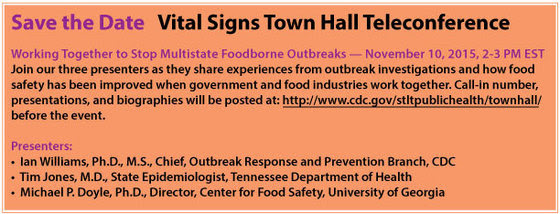
November 3, 2015 | Stopping Multistate Foodborne Outbreaks
Stopping Multistate Foodborne Outbreaks
CDC Report: Working Together to Stop Outbreaks and Make Food Safer
Multistate outbreaks cause more than half of all deaths in foodborne disease outbreaks despite accounting for only a tiny fraction (3 percent) of reported outbreaks in the United States, according to a new Vital Signs report released today. Recent outbreaks of foodborne illness linked to tainted cucumbers, ice cream and soft cheeses show the devastating consequences when food is contaminated with dangerous germs before it reaches a restaurant or home kitchen

Report Highlights
Highlights from the report on multistate foodborne outbreaks during 2010-2014 include:
- An average of 24 multistate outbreaks occurred each year, involving two to 37 states.
- Salmonella accounted for the most illnesses and hospitalizations and was the cause of the three largest outbreaks, which were traced to eggs, chicken and raw ground tuna.
- Listeria caused the most deaths, largely due to an outbreak caused by contaminated cantaloupe in 2011 that killed 33 people.
- Imported foods accounted for 18 of the 120 reported outbreaks. Food imported from Mexico was the leading source in these outbreaks, followed by food imported from Turkey.

Food Industries and the Government Can Work Together to Stop Outbreaks and Make Food Safer
|
The report highlights the need for food industries to play a larger role in improving food safety by following best practices for growing, processing, and shipping foods. In addition, food industries can help stop outbreaks and lessen their impact by keeping detailed records to allow faster tracing of foods from source to destination, by using store loyalty cards to help identify what foods made people sick, and by notifying customers of food recalls.
|
About Vital Signs
Visit the Safer Food Saves Lives Vital Signs Web page to find the research article from the Morbidity and Mortality Report (MMWR), fact sheet, and other materials.
|




































No hay comentarios:
Publicar un comentario